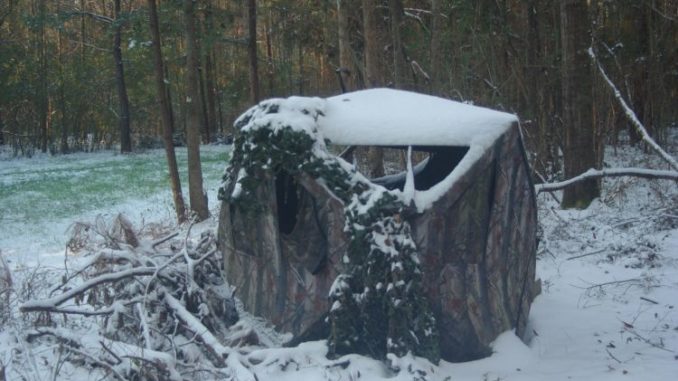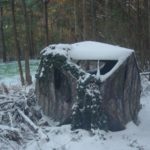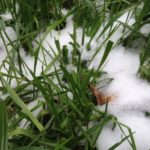
And post-freeze, how’s your deer habitat doing?
Yes, that’s right — for the first time in the lifetime of this author there is no turkey hunting in Louisiana in March. Of course, I grew up hunting in North Louisiana in the 60s and there were no turkeys to hunt in those days. LDWF was trying to restock birds in that area but for various reasons, the restocking effort was not working.
Hopefully you read the hunting regulations and saw that the state season does not open until April 7. So what exactly is going on — have the LDWF turkey biologists gone off the deep end? While some probably think so, this new season structure is an attempt to make sure hens have been bred and are sitting on eggs when the season opens before toms are removed from the population. The later season structure has been in effect for many years in North Louisiana and it seems to be working. When I go deer hunting in Bossier Parish on my friend’s lease I see adult gobblers, jakes and hens. The habitat is very similar to what we have in East Feliciana Parish: lots of pine timber, hardwood drains and fields. But the fact is we do not have a good population of turkeys in my area of the parish and I’m ready to see if this late season will help.
In 2015, I had a good population of turkeys visiting our property — but when the 2016 March flood hit, the turkeys disappeared. Our property does not flood, so I’m not certain what caused the birds to move out. Three hens came back in early summer with some poults, and then the August 2016 flood hit and the turkeys were gone again — and this time they haven’t returned. The 2016 season was a bust, as was the 2017 season. I found a dead gobbler on the property during the 2017 season that died from a disease which affects the immune system and causes organ failure. Unfortunately, this disease has been found in other locations in the state.
The fact is Louisiana does not have the turkey population that other southeastern states such as Mississippi and Alabama do. This new season structure is an attempt by LDWF to increase turkey numbers where populations have declined. It will take several years to determine if this strategy will work. No doubt there are hunters in the state who are much opposed to this new season structure, and will make attempts to change it. A quote from the book “Turkey Hunting- A One-Man Game” by the late Ken Morgan sums it up: “Spring turkey seasons are often set according to politics and sometimes have little to do with sound biological reasons given by game biologists. This needs to change for the good of the turkey.”
What condition is your deer herd in?
LDWF biologists have begun looking at harvest data from the deer killed this past season across the state. As a hunter or deer manager, you should already have an idea of what condition your deer herd is in. Antler quality, body weight and reproduction are all indicators of herd health. The Big Buck Contest at the Louisiana Sportsman Show will provide some insight as to herd condition. Deer scoring 130 or better are good quality deer, while adult deer that score 110 or less probably indicate that there are problems in the paradise you hunt.
A better question might be, ‘Do you know what condition your habitat is in?’ March is usually the month that green-out begins in the state, although in past years with mild winters green-out started earlier in February. This year we experienced a bitterly cold winter; there were three fronts that brought severe freezing temperatures to the Bayou State in December and January. Two of these fronts came with snow, with the snow from the last front lasting for several days. From what I saw the deer hunkered down and did not move too much, but the habitat took it on the chin.
The freezing weather killed or set back much of the native vegetation. If your habitat is lacking in quality browse and nutrition, deer may spend a lot of time this spring trying to catch-up with body growth and maintenance. This could equate to lower body weights and smaller antlers next season. If, on the other hand, you have been managing your habitat and doing the timber work to put quality browse species such as blackberries, greenbriar, honeysuckle, elderberry and a few other species on the ground and available for deer, the population should be in good shape at the start of green-up. In addition to the timber work, food plots planted with nutritious forages would have also benefited the deer during the freeze days.
Despite what you may have heard over the years, the acorn crop is important to our Louisiana deer herds. At the start of the season there was a decent white oak and cow oak acorn crop that deer feasted on. The red oak crop, other than striped oak in some of the bottomland forests, was poor and consequently this was a year that corn feeding would have benefited the deer. Striped oaks are the last acorns to fall in late winter, and on some areas that I visited both deer and hogs were feeding on them heavily. Kidney fat is an indicator of good herd health, and I saw low kidney fat in my area due to the poor acorn crop — but in the bottomland areas that had a good striped oak crop, the kidney fat levels were high.
Over the next few months I will be writing about harvest data and what it means to hunters and managers. I am looking forward to seeing you at the Louisiana Sportsman Show this month in Gonzales.




